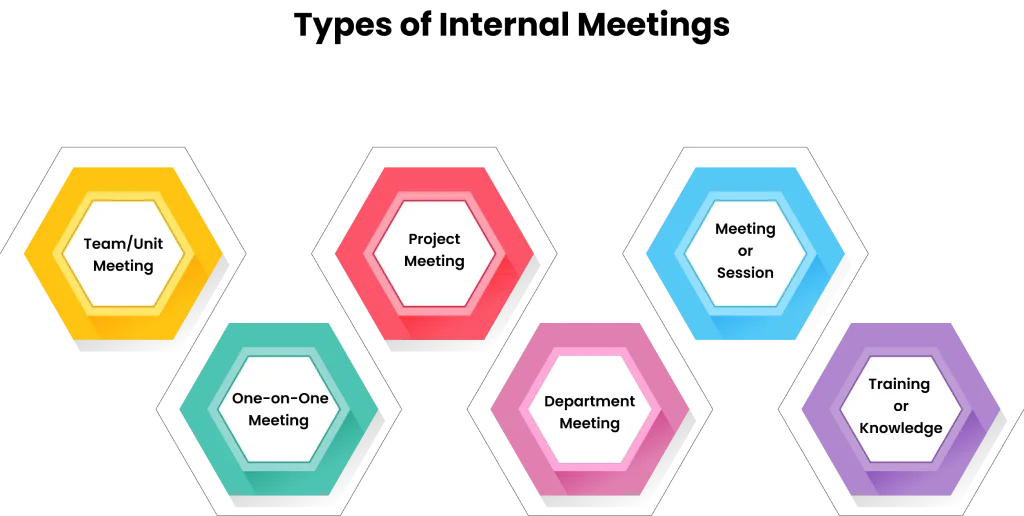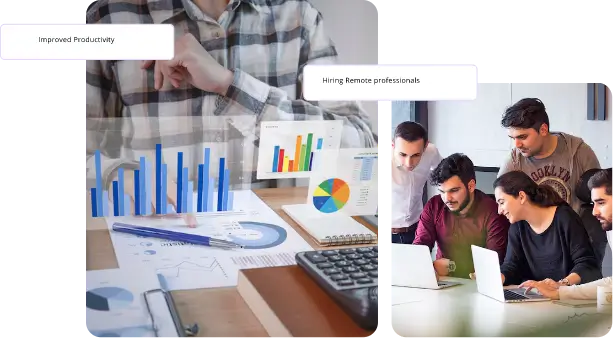Internal Meetings: Definition, Types, Examples & Best Practices
Internal meetings play an important role in any organization. Internal meetings are meetings between employees, teams, and departments to share information, discuss goals, solve problems, and make decisions. Internal meetings can take various forms, including weekly team syncs, strategy meetings, or performance reviews. They are a way to keep everyone aligned and work progressing.
When done well, internal meetings foster collaboration, create transparency, and support more timely decision-making. However, without planning, they can be unproductive. Therefore, it’s important to know what an internal meeting is, the types of internal meetings, and how to succeed during internal meetings. This blog will provide everything you need, from definitions, best practices, and common mistakes.
What Is an Internal Meeting?
An internal meeting is a meeting that is organized and facilitated within an organization. An internal meeting involves employees or teams within an organization and can serve various purposes or objectives. In general, an internal meeting is used to communicate with one another, collaborate on work-related matters, and coordinate responsibilities.
Employers hold internal meetings for many purposes, including sharing updates, setting goals, brainstorming ideas, and reviewing performance. Internal meetings allow employees to stay in sync with the other members of the group or team, while also allowing managers to see progress and provide guidance, avoiding unnecessary delays in resolving issues.
The goal of internal meetings is not merely discussion; the goal is action. A good internal meeting allows teams to get in alignment with each other and provides resolutions to their development by saving time investigating questions. Successful internal meetings develop team members further by building a more solid bond among them. Internal meetings foster a safe environment for members to communicate, provide feedback, and make decisions with each other. Team members are also likely to feel empowered through an internal meeting where they feel acknowledged, regardless of where the meeting may lead them.
The full spectrum of internal meetings, from daily stand-ups to quarterly reviews, serves a purpose in driving organizational success. Feeling included, involved, and informed naturally boosts employee motivation and engagement with organizational objectives.
In our fast-paced hybrid workplace, internal meetings can be more than a conversation; they can be a driver for building culture and productivity across physical work locations.
What Are the Key Components of a Successful Internal Meeting?
1. Clear Purpose
Every meeting should have a clear purpose, aiming to achieve a specific outcome. Whether that purpose is to solve a problem, provide an update on a project, or assign next steps, with a clear sense of purpose in mind, set the tone for the meeting and also help to keep the discussion focused on a relevant direction.
2. Agenda
An agenda consists of a list of items that need attention. Sharing an agenda with attendees before the meeting helps them prepare and focus on what needs to be done.
3. Appropriate Participants
Only invite those who need to be there. If there are too many unnecessary participants, there is a much greater chance of distractions and confusion.
4. Use of Time
Start the meeting at the scheduled time. Finish at the planned time. Stick to the time set for each agenda item. Avoid long or off-topic discussions that take up too much time on one topic.
5. Action Items
After the meeting, you should always identify key takeaways or next steps. After a discussion, you should assign responsibility and deadlines so that everyone knows what they need to do in response to the meeting.
What Are the Different Types of Internal Meetings?

1. Team/Unit Meeting
This is a scheduled regular time to check in with the team around ongoing projects, activities, deadlines, etc.
2. One-on-One Meeting
This meeting generally involves discussions between a manager and the employee, covering elements like performance, feedback from others, career development, and concerns.
3. Department Meeting
This meeting usually consists of all the members of a department and is also similar to a team meeting where managers announce updates about the integrity of the department, updates on new policies and goals, etc.
4. Project Meeting
This meeting is usually focused and much less formal but allows the teams to talk about a specific project and plan, monitor progress on a pre-established agenda, concerns, or obstacles before, so that problems can be dealt with more expeditiously.
5. Brainstorming Meeting or Session
Brainstorming sessions allow teams/units to come together somewhat creatively and less formally to generate new ideas, create solutions to concerns or problems, or plan for innovations.
6. Training or Knowledge Sharing Meeting
An internal planning meeting conducted to train employees, develop best practices, and share tools, concepts, or processes developed with other groups doing those functions.
This meeting is carried out for the purposes of planning strategic directions for the long term, sharing business strategies, or identifying strategic goals for the department.
How to Plan a Productive Internal Meeting?
Step 1: Define your Objective
Clarify the purpose of the meeting. Will you be making a decision, checking in on a plan, or generating ideas?
Step 2: Create an Agenda
Please take notes of your agenda items and how long you anticipate each will take.
Please also share a copy with everyone at least one day before the meeting.
Step 3: Schedule the Meeting Appropriately
Schedule the meeting for times when most people can attend. Scheduling meetings for early in the morning, late in the afternoon, or during lunch is not an appropriate time.
Step 4: Invite Only Those Necessary
Invite only necessary participants. Generally, the smaller the meeting, the better it is for all of those involved.
Step 5: Use Tools as Needed
Feel free to use video conferencing methods (if the group is comfortable with it) such as Zoom or WebEx, share your screen, whiteboards, etc., whichever way that will help you achieve your meeting objectives.
What Are the Best Practices for Conducting Effective Internal Meetings?
1. Start with a Review
Start your meeting with a summary of what was discussed in your previous meeting and which outstanding actions are in which state.
2. Ask for Participation
Give everyone a chance to say something. Make sure you ask for input, ideas, and feedback to create a conversation that goes both ways.
3. Note Agendas
Don’t allow the meeting to go off topic. Politely steer it back on track if the conversation goes off track.
4. Note Taking
Please assign someone to take meeting notes so that a summary and action items can be shared afterward.
5. Review Decisions
Upon completion, swiftly review the decisions made and the subsequent steps.
What Are the Common Mistakes to Avoid in Internal Meetings?
1. Unclear Objective
Meetings without an objective can result in time wasted, probably because the meeting moves along without purpose. Always develop an agenda and circulate it in advance.
2. Inviting Everyone
Not everyone needs to attend every meeting. Involve only team members whose contributions are valuable.
3. Talking Too Much
Lengthy meetings tend to lose engagement. Keep it short and sweet and focus on key learning points and decisions to be made.
4. Not Following Up
If a summary of the meeting or an action list is not sent afterward, the meeting may not be as effective.
5. Ignoring Time
Starting late or holding a meeting longer than scheduled can impact the productivity of everyone upstream and downstream.
How Internal Meetings Differ from External Meetings
Only individuals within the organization, such as employees, teams, or departments, attend internal meetings. Internal meetings happen while providing information or sharing updates internally, meeting regarding a task or planning a task, or meeting to get past an internal issue.
External meetings involve people outside of your organization, clients, vendors, partners, and stakeholders. External meetings involve interacting concerning a business deal, providing a client with an update, discussing a project, or presenting a solution supported by business ideas.
The tone, agenda, and formality differ. Internal meetings may be more casual, can provide more detailed information, and often emphasize the values of the organization and its culture. An external meeting tends to be more formal, more client-focused, and accepted as a normalized commercial practice.

